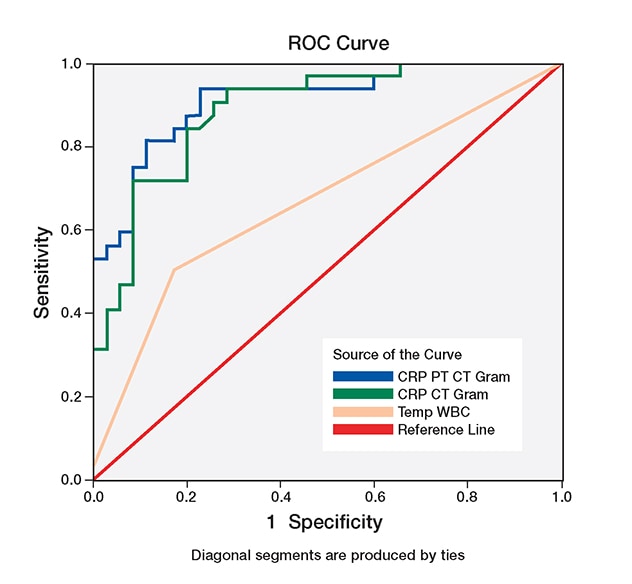May 09, 2019
The problem with obstructing stones and infection
Curva ROC de los factores de urocultivo positivos

Curva ROC de los factores de urocultivo positivos
Curva característica operativa del receptor (ROC) para varios factores asociados con el urocultivo positivo: proteína C reactiva (PCR), procalcitonina (PCT), tinción de Gram positiva (Gram), "stranding" periureteral o perinéfrico en la tomografía computarizada (TC), recuento de glóbulos blancos (GB), temperatura elevada (Temp)
Kidney stones are one of the most common conditions urologists treat, with a prevalence of 10 percent in the United States. The cost of evaluation and treatment of stones has risen to $2 billion, according to research by Charles D. Scales Jr., M.D., and others, published in European Urology in 2012.
When patients present to the emergency department with an obstructing urinary stone, one of the most pressing determinations for the urologist is whether the urine is infected, as this situation can quickly become life-threatening. Such infections require urgent decompression in the form of ureteral stent or nephrostomy tube placement. In the setting of truly infected urine, these procedures are necessary, but if the urine is not infected, proceeding emergently to these interventions is accompanied by unnecessary risk and costs.
Unfortunately, many times it can be difficult for providers to accurately identify which patients warrant decompression, as the results of urine cultures are not available within the rapid time frame of decision-making. Other signs and symptoms of infection, such as fever, chills, elevated white blood cell count, and positive nitrites or leukocytes on urinalysis, have been found to be poor predictors of eventual positive urine cultures.
A team of researchers at Mayo Clinic in Rochester, Minnesota, recently reviewed the records of approximately 100 patients who underwent stent or nephrostomy tube placement for suspicion of an infected stone. They found that use of these traditional markers to predict infection resulted in only 50 percent of patients with suspected infection being confirmed to have a urinary tract infection based on culture, which is considered the gold standard.
Looking to improve their ability to predict infection and identify better indicators of infection, the research team added C-reactive protein and procalcitonin, two markers with promising data as predictors of infection and urosepsis, to the evaluation of possible infected stones. Research supporting the markers as predictors was published in Journal of Endourology in 1996, Journal of Urology in 2005 and Journal of Infection and Chemotherapy in 2018.
Prior patient experience guides future predictive modeling
In addition to including these more novel markers, the research team examined many factors ― clinical characteristics, imaging findings, blood test results and urine studies ― to determine which were ultimately associated with culture-proven infections. In a stepwise multivariate regression model, these factors were then used to develop a risk score to predict clinically significant infection.
Ultimately, among over 30 factors evaluated, four were found to be significant predictors of infection and were included in the determination of a novel risk score:
- Positive urine Gram's stain
- The presence of perinephric or periureteral fat stranding on CT imaging
- C-reactive protein elevation greater than 21.95
- Procalcitonin elevation greater than 0.36
With 1 point for each positive factor, the chances of a confirmed urinary tract infection were found to be 8 percent, 11 percent, 68 percent and 100 percent for risk scores of 0, 1, 2 and 3-4, respectively.
Implementing research into clinical practice
This work has generated a novel tool with the potential to improve urologists' ability to predict which patients will have clinically significant urinary tract infections in the setting of an obstructing stone. The researchers hope that the use of the risk score will lead to a shift in triage of patients with obstructing stones, allowing urologists to better counsel patients, avoid unneeded procedures and decrease health care costs. In the future, the group will work to validate its findings.
For more information
Scales CD, et al. Prevalence of kidney stones in the United States. European Urology. 2012;62:160.
Wolff JM, et al. Early detection of infected ureteral obstruction after SWL employing C-reactive protein. Journal of Endourology. 1996;10:523.
Yilmaz E, et al. The comparison and efficacy of 3 different alpha1-adrenergic blockers for distal ureteral stones. Journal of Urology. 2005;173:2010.
Yamamichi F, et al: Comparison between non-septic and septic cases in stone-related obstructive acute pyelonephritis and risk factors for septic shock: A multi-center retrospective study. Journal of Infection and Chemotherapy. 2018;24:902.